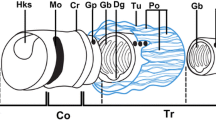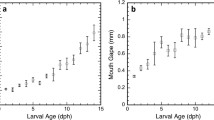Abstract
We describe aspects of the anatomy and suspension-feeding mechanism of a single Planctosphaera pelagica captured from the plankton in June 1992 off Bermuda in the western Atlantic. We also describe several unusual features of the larva, including its occurrence in surface waters, unusually large size, and limited swimming ability. Our account of the form and feeding behavior of P. pelagica is the first based on observations of a specimen captured and observed alive. Our limited observations suggest that the planctosphaera may use a suspension-feeding mechanism much like that of the other feeding deuterostome larvae (the pluteus and bipinnaria larvae of echinoderms and the tornaria larva of enteropneust hemichordates) known to capture food particles using a single ciliated band. Although we could not observe cilia directly, the movement of dye streams and food particles and the structure of the ciliated band suggest that some particles may be captured at the ciliated band by the reversal of ciliary beat. The planctosphaera possesses many prominent mucous glands near the food grooves. This suggests an important role of mucus in the biology of the larva, but we were not able to observe directly any role of mucus in particle capture.
Similar content being viewed by others
References
Åkesson B (1961) On the histological differentiation of the larvae of Pisione remota (Pisionidae, Polychaeta). Acta Zool 42: 177–225
Bidigare RR, Biggs DC (1980) The role of sulfate exclusion in buoyancy maintenance by siphonophores and other oceanic gelatinous zooplankton. Comp Biochem Physiol 66A: 467–471
Damas D, Stiasny G (1961) Les larves planctoniques d'enteropneustes (Tornaria et Planctosphaera). Verh K vlaam Acad Wet (Kl Wet) 15: 1–68
Hadfield MG, Young RE (1983) Planctosphaera (Hemichordata: Enteropneusta) in the Pacific Ocean. Mar Biol 73: 151–153
Halanych KM (1993) Suspension feeding by the lophophore-like apparatus of the pterobranch hemichordate Rhabdopleura normani. Biol Bull mar biol Lab, Woods Hole 185:417–427
Hart MW (1990) Manipulating external Ca2+ inhibits particle capture by planktotrophic echinoderm larvae. Can J Zool 68:2610–2615
Hart MW (1991) Particle captures and the method of suspension feeding by echinoderm larvae. Biol Bull mar biol Lab, Woods Hole 180:12–27
Hyman LG (1959) The Invertebrata: smaller coelomate groups. Vol. 5. McGraw-Hill, New York
Lalli CM, Gilmer RW (1989) Pelagic snails: the biology of holoplanktonic gastropod mollusks. Stanford University Press, Stanford
Rassoulzadegan F, Fenaux L, Strathmann RR (1984) Effect of flavor and size on selection of food by suspension-feeding plutei. Limnol Oceanogr 29:357–361
Scheltema RS (1970) Two new records of Planctosphaera larvae (Hemichordata: Planctosphaeroidea). Mar Biol 7:47–48
Spengel JW (1932) Planctosphaera pelagica. Rep “Michael Sars” N Atlant Deep-Sea Exped 1910. 5:1–27
Strathmann RR (1971) The feeding behavior of planktotrophic echinoderm larvae: mechanisms, regulation, and rates of suspension feeding. J exp mar Biol Ecol 6:109–160
Strathmann RR (1982) Cinefilms of particle capture by an induced local change of beat of lateral cilia of a bryozoan. J exp mar Biol Ecol 62:225–236
Strathmann RR (1988) Functional requirements and the evolution of developmental patterns. In: Burke RD, Mladenov PV, Lambert P, Parsley RL (eds) Echinoderm biology. A. A. Balkema, Rotterdam, pp 55–61
Strathmann RR (1989) Existence and functions of a gel filled primary body cavity in development of echinoderms and hemichordates. Biol Bull mar biol Lab, Woods Hole 176:25–31
Strathmann RR, Bonar D (1976) Ciliary feeding of tornaria larvae of Ptychodera flava (Hemichordata: Enteropneusta). Mar Biol 34:317–324
Strathmann RR, Jahn TL, Fonseca JRC (1972) Suspension feeding by marine invertebrate larvae: clearance of particles by ciliated bands of a rotifer, pluteus, and trochophore. Biol Bull mar biol Lab, Woods Hole 142:508–519
Tranter PRG, Nicholson DN, Kinchington D (1982) A description of spawning and post-gastrula development of the cool temperate coral, Caryophyllia smithi. J mar biol Ass UK 62:845–854
Van der Horst CJ (1936) Planktosphaera and tornaria. Q Jl microsc Sci 78:605–613
Werner B (1953) Beobachtung über den Nahrungserwerb und die Metamorphose der Metatrochophora von Chaetopterus variopedatus Renier u. Claparede (Polychaeta Sedentaria). Helgoländer wiss Meeresunters 4:225–238
Author information
Authors and Affiliations
Additional information
Communicated by M. G. Hadfield, Honolulu
Rights and permissions
About this article
Cite this article
Hart, M.W., Miller, R.L. & Madin, L.P. Form and feeding mechanism of a living Planctosphaera pelagica (phylum Hemichordata). Marine Biology 120, 521–533 (1994). https://doi.org/10.1007/BF00350072
Received:
Accepted:
Issue Date:
DOI: https://doi.org/10.1007/BF00350072




